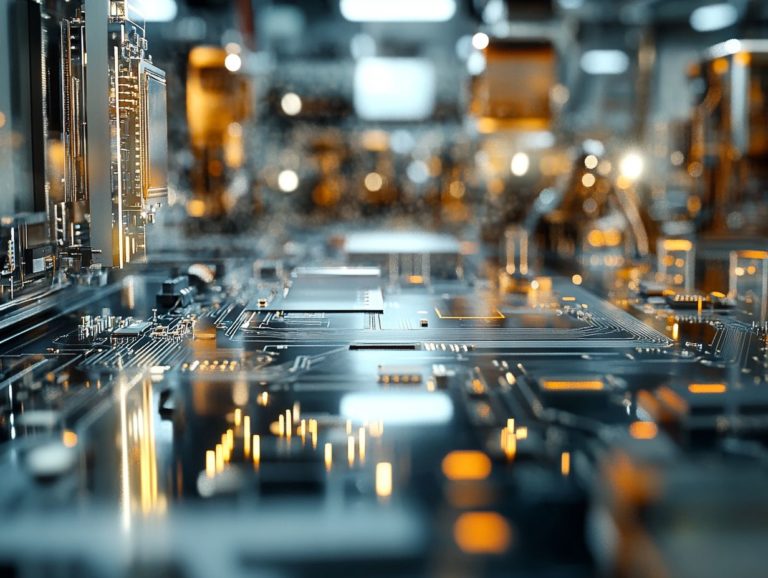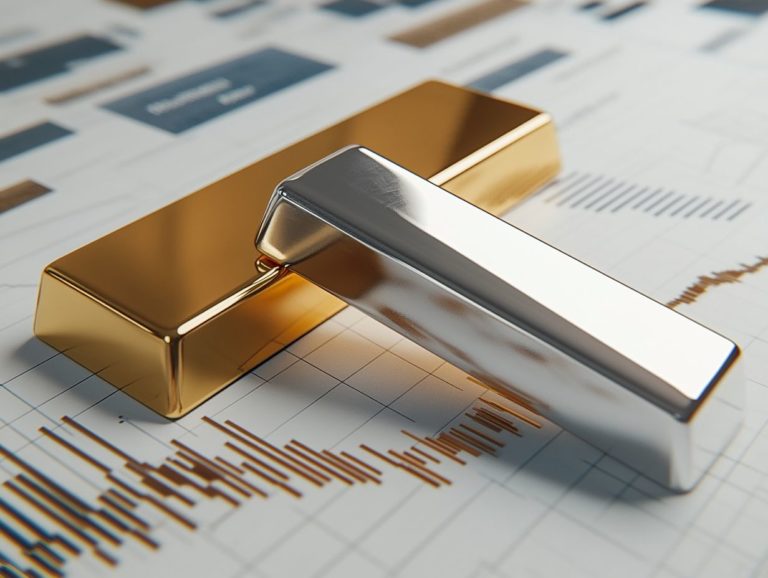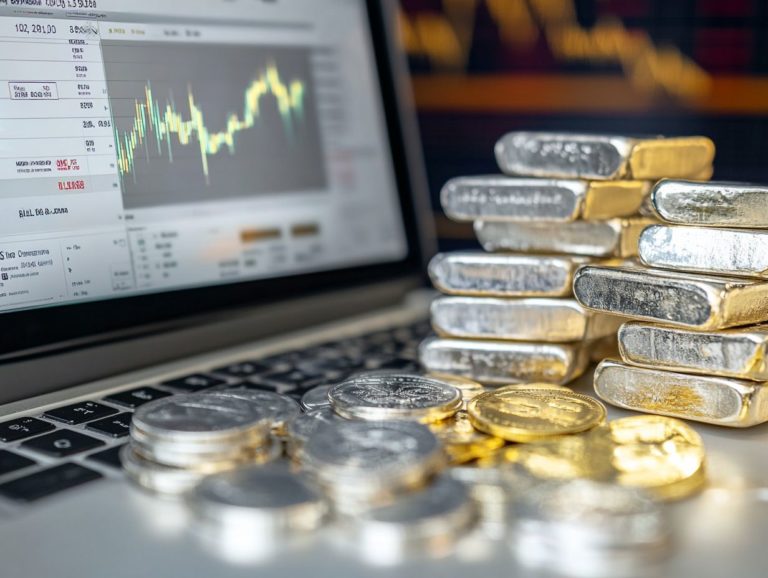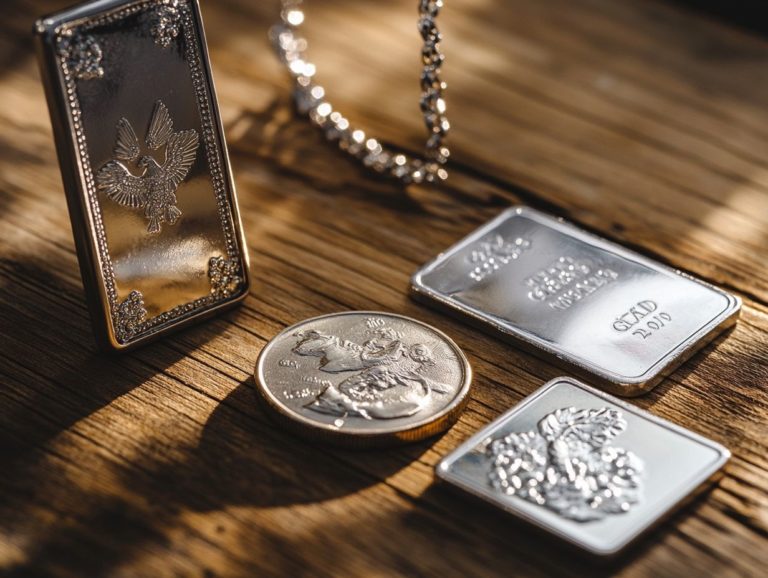The Science Behind Platinum’s Value
Platinum, a precious metal celebrated for its rarity and unparalleled properties, holds a vital position across numerous industries and markets.
This exploration highlights the captivating characteristics of platinum. It focuses on its unique traits and various applications.
It explores the factors that impact its value. These include supply, demand, and trends in industrial and investment interest.
It highlights trends and growth potential, which may shape platinum’s economic impact.
Contents
Key Takeaways:
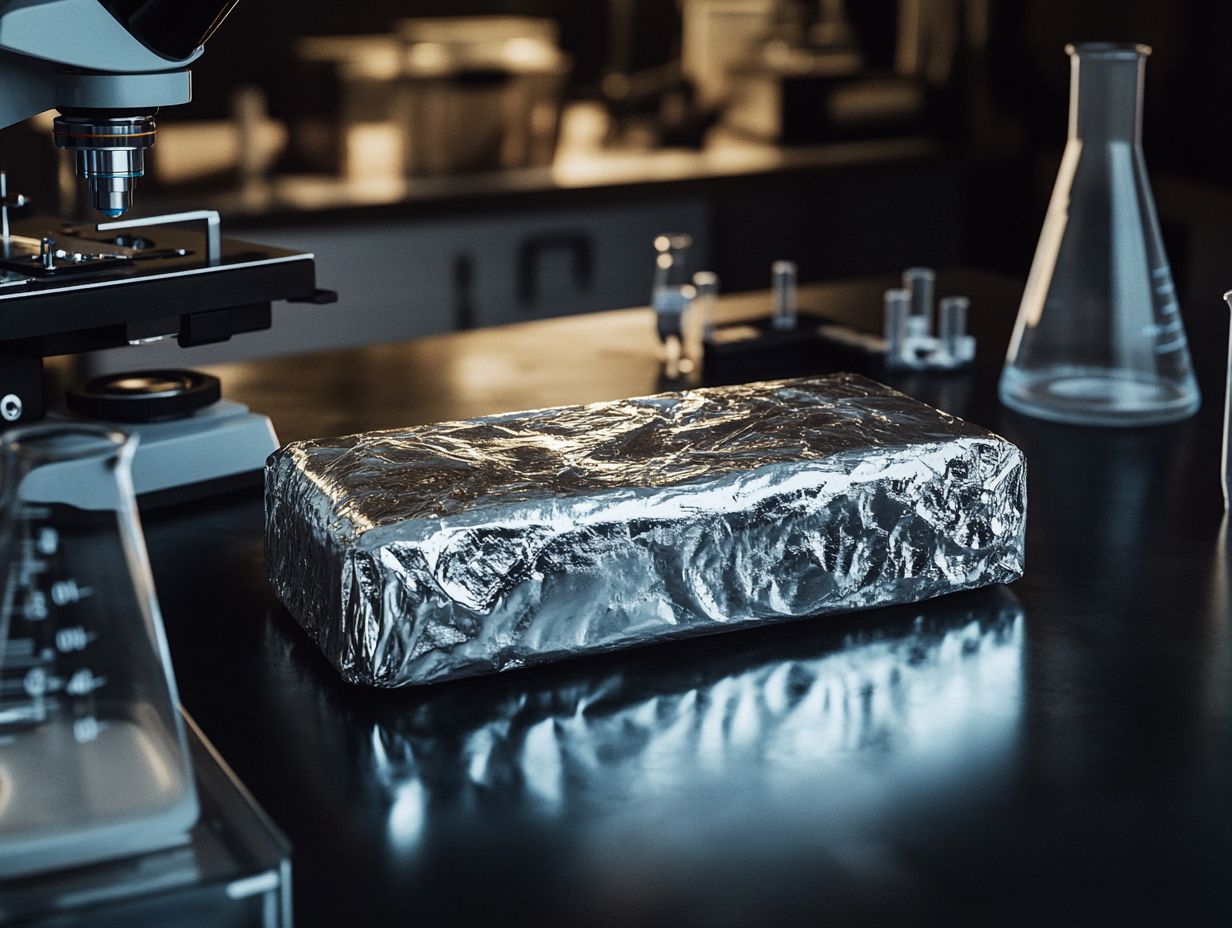
Overview of the Metal and its Uses
Platinum, a highly esteemed precious metal, stands out for its distinctive properties and versatile applications across various commercial industries. Its historical significance stretches back centuries, making noteworthy contributions in sectors like automotive, where it plays an essential role in catalytic converters, and jewelry, where it acts as a reliable store of value for discerning buyers.
As a rare and coveted commodity, the mining and production of platinum are crucial in fulfilling the robust demand from global markets. This solidifies its position as a key player in today s precious metals landscape.
Properties of Platinum
Platinum stands out as a truly remarkable chemical element, recognized for its exquisite white luster and exceptional physical properties. This precious metal is in high demand across various industries due to its impressive characteristics.
With a high melting point and boiling point, platinum showcases unique elemental traits that enhance its utility in both industrial applications and elegant jewelry design.
Its diverse oxidation states, combined with outstanding chemical resistance, further amplify the versatility of platinum compounds, making them invaluable in a range of uses.
Unique Characteristics and Applications
The unique characteristics of platinum, such as its high boiling point and favorable oxidation states, make it essential in various applications, especially in the automotive industry and jewelry design. Its exceptional durability and resistance to tarnishing are why jewelry buyers often gravitate toward items like platinum engagement rings. Simultaneously, these unique properties facilitate advanced industrial applications.
In the automotive sector, platinum plays a crucial role in catalytic converters. Its remarkable catalytic properties help convert harmful emissions into less harmful substances, promoting environmental sustainability something you can feel good about.
The increasing trend of recycling platinum adds to its allure; it can be reclaimed from old jewelry or industrial waste, leading to reduced costs and supporting sustainable practices. This blend of functionality in industrial settings and aesthetic appeal in fine jewelry solidifies platinum s status as a highly sought-after material, ensuring robust demand in both markets.
Factors Affecting Platinum’s Value
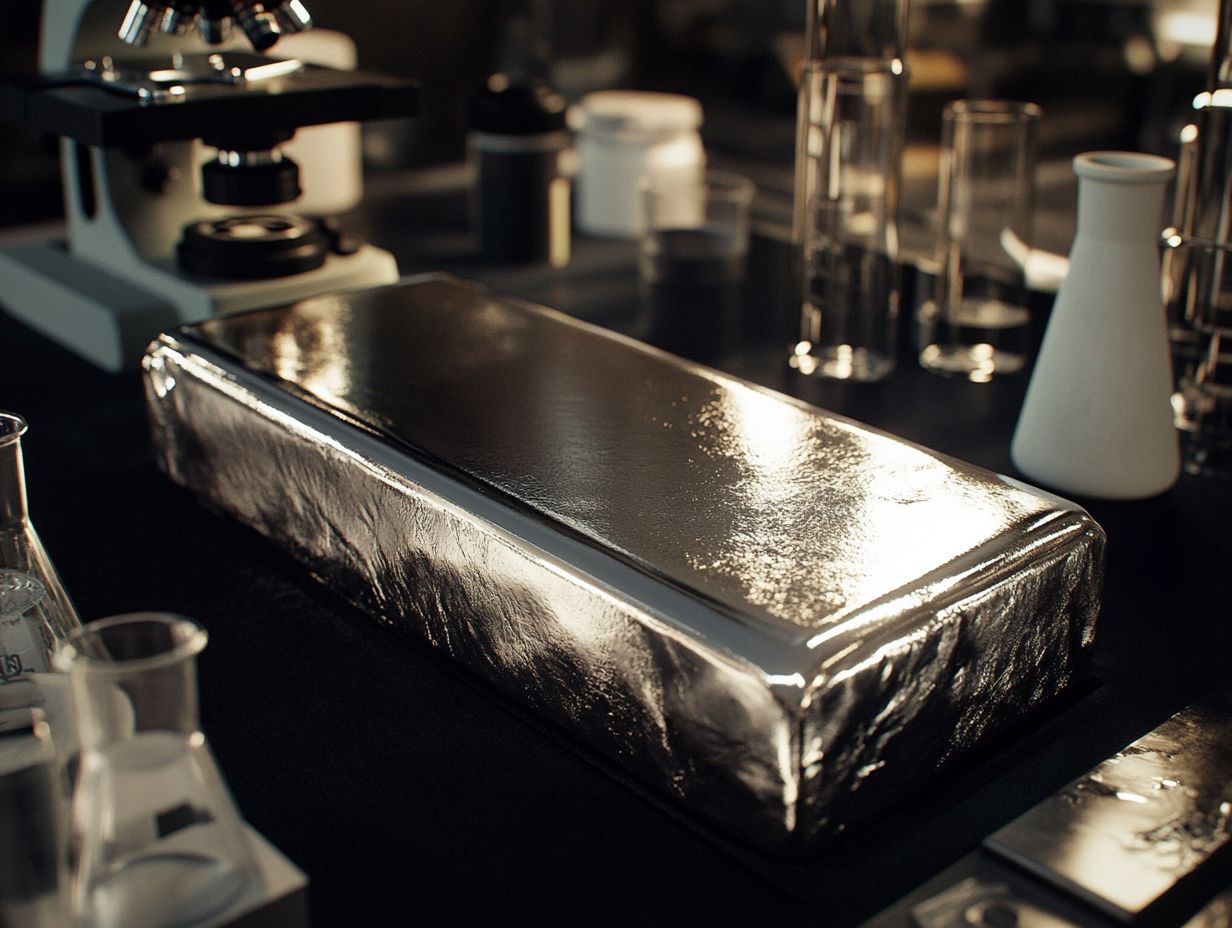
The value of platinum is shaped by a range of factors, such as market fluctuations, supply and demand dynamics, and the overall confidence of investors in the precious metals sector. It s essential for you to grasp how these elements interplay in the realm of platinum trading.
This understanding is crucial, whether you re an industry professional or an investor, particularly when it comes to platinum group metal (PGM) reserves and the trading instruments at your disposal. Platinum group metals (PGMs) are a group of precious metals that include platinum, palladium, and rhodium.
Supply and Demand
The intricate balance of supply and demand for platinum is shaped by global output. Mining production capabilities of key players in the industry also play a crucial role.
Countries such as South Africa, Russia, and Zimbabwe are the titans of the global platinum supply. South Africa alone is responsible for nearly 70% of the world s production.
These nations possess vast mineral resources, directly impacting their output levels. This, in turn, alters market pricing.
As mining production experiences fluctuations whether due to labor strikes or regulatory shifts prices can swing dramatically, either spiking or dropping significantly.
The significance of existing platinum reserves cannot be overstated. They serve as a crucial buffer against supply shocks and sustain the market during heightened demand.
Ultimately, they stabilize the entire industry. Understanding this landscape equips you with the insight needed to navigate the complexities of platinum investments effectively.
Industrial and Investment Demand
Both industrial applications and investment demand significantly shape the overall demand for platinum. Its roles in catalytic converters and jewelry making stand out.
As a precious metal, platinum serves not just as a financial asset but also attracts jewelry buyers who appreciate its durability and beauty.
In the automotive industry, platinum’s catalytic properties help reduce harmful gases from vehicle exhaust. This makes it essential for today s vehicles.
This increasing focus on sustainability and adherence to regulatory standards elevates the demand for platinum in manufacturing.
The jewelry market values platinum for its rarity and resistance to tarnishing. It appeals to affluent consumers seeking unique and enduring pieces.
Another key factor influencing platinum’s supply is recycling. A substantial amount of the metal is reclaimed from old catalysts and jewelry, contributing to market stability.
Recognizing these diverse applications positions platinum not only as a valuable investment but also as a critical material in the contemporary economy.
The Role of Platinum in the Economy
Platinum holds a crucial position in the economy, significantly influencing various commercial industries and bolstering the precious metals market.
See how it impacts the economy across multiple sectors. It reinforces investor confidence and drives innovations in mining techniques, enhancing production efficiency.
Impact on Various Industries and Markets

The impact of platinum on various industries and markets is profound, especially in the automotive and jewelry sectors, where it plays critical roles.
Fluctuations in mining production and global demand directly shape the market, highlighting the metal’s versatility and economic significance.
In the automotive realm, platinum is essential for catalytic converters, vital for reducing harmful emissions from vehicles. This underscores its importance in sustainability efforts.
The growing demand for cleaner technologies aligns closely with market trends, substantial mining output, and shifts in consumer behavior.
In the jewelry industry, platinum s rarity and aesthetic appeal make it a top choice for high-end pieces. This reflects economic factors like consumer purchasing power and luxury spending trends.
Grasping how supply and market changes interact gives you useful insights into how this precious metal influences the global economy.
Exciting Future Trends in Platinum Investment
The future outlook for platinum is promising don t miss out on the opportunities ahead! Forecasted trends suggest strong growth potential in the years ahead.
As the precious metals market evolves, platinum’s unique properties are poised to play a pivotal role in determining its trajectory. This creates exciting opportunities for those who keep a keen eye on the market.
Forecasted Trends and Growth Potential
Forecasted trends for platinum indicate a promising upward trajectory, driven by rising demand for investment and innovative recycling methods. Grasping these market dynamics is vital for savvy investors like you aiming to make informed decisions.
Greener technologies are gaining traction, especially within the automotive sector with the emergence of hydrogen fuel cells. This shift is sparking increased interest in this precious metal. The tightening of global supply chains and stricter environmental regulations around mining activities highlight the growing significance of recycled platinum as a sustainable alternative.
As industries transition to eco-conscious practices, maintaining a delicate balance between new extraction and recycling becomes essential not just for sustaining supply but also for stabilizing market prices. Staying attuned to these evolving trends is vital, as they will profoundly affect the demand and overall market landscape for platinum in the years ahead.
Frequently Asked Questions
-
What is the chemical structure of platinum?
The chemical symbol for platinum is Pt, and its atomic number is 78. It belongs to the group of elements known as transition metals, which are characterized by their high density and malleability.
-
How do platinum’s chemical properties contribute to its value?
Platinum’s resistance to wear and high melting point make it a valuable metal for industrial and technological applications. It is also a catalyst for chemical reactions, essential in producing many products.
-
What is the history of platinum’s use and value?
Platinum has been used by ancient civilizations like the Egyptians, Romans, and Incas for jewelry and decorative purposes. Its value increased greatly in the 1700s when it was discovered to be a key component in manufacturing scientific instruments.
-
How does platinum’s rarity affect its value?
Platinum is a rare metal, with an estimated 10 times less being mined compared to gold. This rarity and difficulty in extraction add to its market value.
-
Which industries heavily rely on platinum?
Platinum is used in many industries, including automotive, chemical, electrical, and medical. Its versatility and unique properties make it essential in producing various products.
-
How does the economy affect the value of platinum?
The demand for platinum in different industries, as well as its use as an investment metal, can greatly impact its market value. Economic factors, such as supply and demand, inflation, and market trends, also play a significant role in determining platinum’s value.
Don’t miss out on this opportunity! Stay updated with market trends and explore more about investing in platinum.











